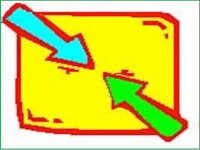Ecosystems Curriculum

This section addresses students' tendency to notice effects in one direction only. It helps students understand that two-way or mutual causal relationships describe many interdependencies in the ecosystem. This section uses stories and computer simulations to help students realize that two-way (or mutual) causality plays a role in ecosystem dynamics.
Section 5: Understanding Goals
Subject Matter
- Symbiosis is the interaction of two species that are in direct contact and typically affect each other—an instance of two-way causality.
- Mutualism is a form of symbiosis where two organisms mutually affect each other in beneficial ways.
- Parasitism is a form of symbiosis where one organism lives off another organism, usually to the detriment of the organism being lived off of.
- While the process of energy flow in an ecosystem is one-way, effects can be two-way with two populations mutually affecting each other.
- In a food web, some organisms (prey) provide food for other organisms (predators). The predators help to keep the prey population in balance. This is a type of two-way causal relationship.
Causality
- What appears to be a one-way causal relationship can be two-way relationship.
- Two-way causal relationships mean that both organisms are affected in some way. The outcomes may be on different levels (population versus individual) or may be beneficial to one species and detrimental to the other, beneficial to both, or detrimental to both.


